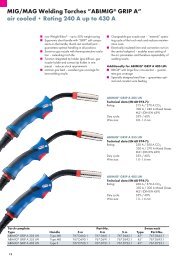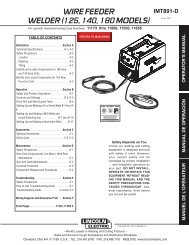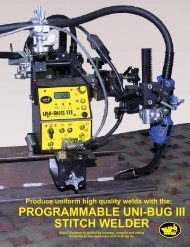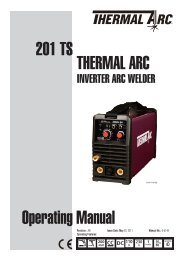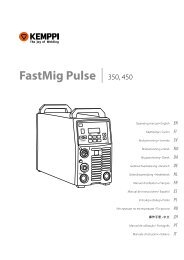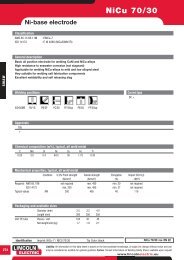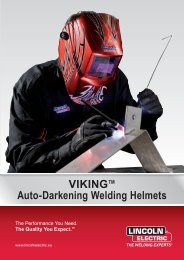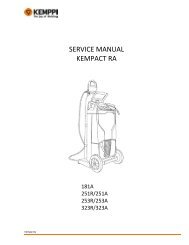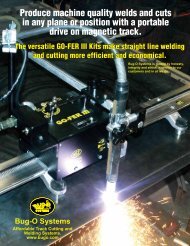mig welding - Rapid Welding and Industrial Supplies Ltd
mig welding - Rapid Welding and Industrial Supplies Ltd
mig welding - Rapid Welding and Industrial Supplies Ltd
You also want an ePaper? Increase the reach of your titles
YUMPU automatically turns print PDFs into web optimized ePapers that Google loves.
THE FIRST 80 YEARSSifbronzing is an almost universally recognisedway of describing the low temperature bronze<strong>welding</strong> of sheet steel, cast iron <strong>and</strong> othermetals. The reason behind this fact summariseswhy Sifbronze, the company which firstdeveloped <strong>and</strong> promoted the technique, isgenerally considered to be a supplier of topquality<strong>welding</strong> rods, wires, fluxes <strong>and</strong>equipment.In 1914 a young man called Louis Tibbenhamtook on part of a factory in Stowmarket whichhad gone bankrupt, <strong>and</strong> set up his owncompany, the Suffolk Iron Foundry, to makecastings such as flywheels <strong>and</strong> ploughshares.Just as the business got going, the Great Warstarted, the bank-rate went up <strong>and</strong> businessground to a halt. It looked as though thecompany was doomed.However, Louis Tibbenham struggled on,picking up small contracts <strong>and</strong> learning, in manycases by bitter experience, about business. Atone stage, having built up a good trade inploughshares, he signed a contract which, hediscovered later, forced him to stop makingthem. So he turned to making mangles; then,before the age of the tumble-drier, an essentialpart of every household's washing equipment.By the end of the Great War the company wasdoing well. It had grown too big for its premises<strong>and</strong> so another site, some six acres of bog <strong>and</strong>rubbish tip by the River Gipping in Stowmarket,was bought for £500. The railway companyprovided a siding close by <strong>and</strong> work began onthe site. The whole site was planned by LouisTibbenham, <strong>and</strong> the buildings were designed byhim, resulting in his winning a first prize in acompetition run by the Foundry Trade Journal.The new factory coincided with a major contractwhich took up nearly all the Foundry's capacity<strong>and</strong> then, in the form of having too many eggsin one basket, disaster struck <strong>and</strong> the contractwas cancelled. Louis Tibbenham had to findsomething to fill the void <strong>and</strong> so he decided toturn to specialist castings. Prime amongst thesewas the lawn mower, soon to becomerecognised as the 'Suffolk' range.Though casting <strong>and</strong> iron -founding was a majorpart of the business, Louis Tibbenham hadalways been interested in <strong>welding</strong>, <strong>and</strong> duringthe Great War he had met a young engineer inLondon who was experimenting with <strong>welding</strong>cast-iron using an oxy-acetylene flame. SuffolkIron Foundries was asked to supply a few castironrods containing extra silicon. TheyLouis Tibbenham, the founder,photographed in the early 1920’s.performed so well that they became aproduction item in due course, under the br<strong>and</strong>name, 'Super-Silicon Rod'.At around this time Mr Tibbenham learned ofthe techniques of low temperature bronze<strong>welding</strong> for cast-iron, so he developed a rodwhich, subsequently, was found to be suitablefor <strong>welding</strong> virtually any metal exceptaluminium. Taking the initials SIF from SuffolkIron Foundry, <strong>and</strong> adding 'bronze', he gave aname to the technique <strong>and</strong> formed a division toh<strong>and</strong>le the products. The name Sifbronze hasremained a fact in <strong>welding</strong> ever since, <strong>and</strong> hascome to describe a technique which isuniversally accepted.www.<strong>Rapid</strong><strong>Welding</strong>.comOver the years the nature of the company atStowmarket has changed little beyondexp<strong>and</strong>ing to meet increased dem<strong>and</strong> <strong>and</strong>keeping ahead of technology. During theSecond World War most of the company'sefforts were devoted to war work, largely for theRoyal Air Force. This included the production ofground equipment such as the bomb-trolleyswhich were a prominent feature of so many airstations. Sifbronze was used for, amongst manyother military applications, the fabrication of airframes.135Order Before 4pm For NextDay Delivery (Mon-Fri)



